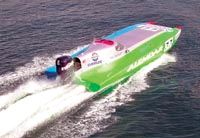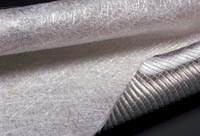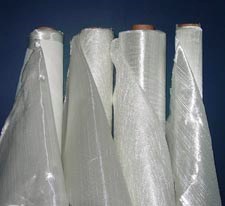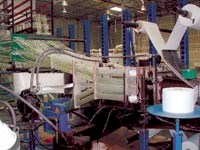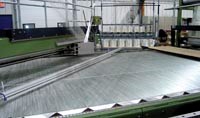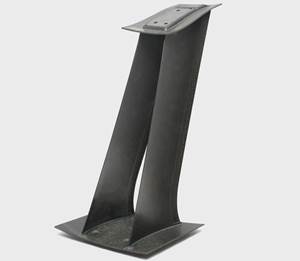Fiberglass multiaxials reinforce their market share
Technological and market forces feed growing use of multiaxial nonwoven fiberglass fabrics and spur diversified product offerings.
Multiaxial nonwoven reinforcements are one of the fastest growing material forms in the composites world today. In the mid-1980s, when multiaxial nonwoven technology began to mature, annual worldwide capacity was about 2.3 million kg/5 million lb. Today, some 45.4 million kg/100 million lb are produced in North America alone. Multiaxial fabric-making machines number about 20 in the United States, but as many as 110 machines operate elsewhere in the world, with much of the expansion occurring since 2000. "We have noted a doubling of industry multiaxial output capacity in North America over the past three years," reports Don Massey, CEO and founder of Vectorply Corp. (Phenix City, Ala.). This growth is attributable to a number of factors, the most significant of which is the fabric itself.
UNI TO WOVEN TO NONWOVEN
For many years, fabricators constructed multiaxial laminates by hand laying unidirectional tapes. This labor-intensive process required manual placement of large numbers of plies into correct orientations, which introduced the relative risk of human error, especially in terms of angle of orientation.
Textile manufacturers improved efficiency and accuracy by weaving fibers together on looms similar to those used to manufacture common varieties of cloth. Woven fabrics consist of two sets of interlaced fibers oriented in the 0° and 90° (length or warp, and width or weft) directions. Parts manufactured with wovens can be layed up with significantly less labor. Moreover, their interlocked layers help prevent delaminations and therefore contribute to high impact resistance -- greater than that produced by multiaxial nonwovens of the same weight. Therefore, parts requiring significant thickness and high stiffness in a solid laminate are often best served by wovens. Additionally, applications requiring areal weights lower than 300 g/m2 (9 oz/yd2) are beyond the limit of what multiaxial machines can cost-effectively produce. For these reasons, wovens (mostly in glass fiber) are expected to maintain a broad application base.
UNCRIMPING YOUR STYLE
That said, the mechanical over/under interlacing of the weaving process bends, or crimps, the woven fibers. As a result, a 0/90 woven fabric can't match the perfomance of two unidirectionals of the same weight stacked in 0/90 orientation. To achieve similar performance in a particular laminate, fabricators who use wovens must therefore increase the total number of oriented layers. By contrast, multiaxial nonwovens consist of two or more unidirectional layers at differing orientations, fixed together by polyester stitching thread or a polymer binder, or both. Because these methods introduce little or no fiber crimp, nonwovens are up to 50 percent stronger, by weight, than woven fabrics.
Each layer is typically oriented in one of four directions: length, width and plus/minus bias (0°, 90°, +45°, -45°). Standard configurations offered by multiaxial fabric suppliers include biaxial (0°, 90°), double bias (±45°), triaxial warp (0°, ±45°), triaxial weft (90°, ±45°) and quadraxial (0°, 90°, ±45°). The fabric form enables multiple plies to be positioned correctly, quickly and easily.
Multiaxials also enable production of parts with higher fiber volume because uncrimped fibers facilitate better resin flow and the basic structure nests fiber bundles closer to one another, eliminating the interstices where resin accumulates in wovens and chopped strand mats. In a study conducted by Devold AMT (Langevaag, Norway) using three fabric types with the same areal weight, a multiaxial fabric was wet out with 72 percent and 44 percent less resin than was required, respectively, to wet out a continuous-strand mat and a woven roving/continuous mat combination.
For the same reason, some companies are tailoring multiaxials specifically for resin infusion processes. "Multiaxials have the ability to channel resin for fast, efficient wetout," notes Kevin Horne, president/CEO of V2 Composites Inc. (Auburn, Ala.). "This is critical both for cost-efficiency and structural efficiency."
Mark Caron, sales and product development manager for Saint-Gobain Technical Fabrics (Valley Forge, Pa.) points to pioneering work by Brunswick Technologies Inc. (now Saint-Gobain BTI, Brunswick, Maine) in super heavyweight multiaxials -- fabrics in weights of 3,300 g/m2 (100 oz/yd2) or more, made in a single step. Such heavyweight nonwovens now enable faster buildup of the bulk often desired in large, closed-molded parts. Use of these fabrics reduces the labor required to layup reinforcements, which helps offset the additional labor required to set up feed lines and seal vacuum bags. Some of the multiaxials are designed with an integrated flow medium, such as a polyester or polypropylene core. A subset, such as Telateks A.S.'s (Istanbul, Turkey) METFLOW, also include channels through which the resin can flow, created by removing some strands during the stitching process.
These factors can dramatically alter outcomes for fabricators and end-users alike. For instance, on a racing catamaran recently built by Alemdar Performance (Istanbul, Turkey), labor was reduced by 30 to 40 percent when the company switched from wovens to METYX biaxial and triaxial nonwovens, supplied by Telateks. Boat weight shrank from 1,300 kg to 901 kg (2,866 lb to 1,986 lb) -- just above the race-rule limit of 900 kg/1,984 lb -- enabling the catamaran to reach speeds of 159 kmh/99 mph while competitors topped out at 129 kmh/80 mph.
Multiaxials also are benefiting pultruders. When Powertrusion International (Las Vegas, Nev.) designed its pultruded power poles (see CT August 2004, p. 29), the company decided at the beginning to incorporate multiaxial fabrics, reports VP of engineering Danny Lonergan. "Finite element analysis showed performance per pound of material was greater with multiaxials instead of all roving," he says. Powertrusion has qualified several vendors. Currently, Fiberex Glass Corp. (Leduc, Alberta, Canada) roving carries the poles' bending loads, while stitched double bias (±45°) fabrics and some continuous strand mat from Owens Corning (Toledo, Ohio) handle the shear loads.
BEYOND STITCHING
In some stitched fabrics, a resin binder, in powder form, is applied to further stabilize the fabric. The binder helps the fabric maintain its architecture through cutting processes and gives it greater wet stability than a stitched-only fabric, i.e., the fibers will not wash out of place with resin flow. However, the addition of binder stiffens the fabric, with a consequent loss of drapability.
Where drapability is not a driver, a multiaxial made with binder but no stitching offers greater strength in the warp (0°) direction because stitching can create a slight wavy pattern in warp fibers, with a corresponding decrease in properties. A binder-only multiaxial also can be less expensive to manufacture, since the complexities of stitching are replaced with the simplicity of laying down the binder. Until recently, binder-only reinforcements were limited to single-layer unidirectional tapes, but recent startup Multi-Axial Fabrics Inc. (Huntington Beach, Calif.) has developed the machinery and polymer formulation to manufacture multiaxial nonwovens by stacking binder-only unidirectionals. Multi-Axial Fabrics started limited production of its StructurPly line of multiaxials on developmental machinery in August of last year. A new San Clemente, Calif. facility, designed for high-volume production, is slated to open early this year (see related news item, this issue, p. 17).
The StructurPly family includes StructurPly IV, a dry multiaxial fabric held together with only 2 wt-% binder, which allows for good infusion of matrix resin. (The line also includes prepregs with 32 to 34 wt-% matrix resin.) To make StructurPly IV, the company's machinery collimates and prestresses the fibers, then spreads them into a web up to 157.5 cm/62 inches wide. In a continuous process, the web passes through a binding chamber, where a proprietary binder is applied and the web is heated under pressure, cooled and then wound onto a take-up roll. From these rolls, other equipment draws unidirectional plies, then slits and stacks them in layers, positioning each in the desired orientation. The assembled plies run through the binding/heating chamber again, where they are consolidated without the need for additional binder. The company claims that fabrics of as many as 24 layers can be produced by this process.
MOVING TOWARD THE MAINSTREAM
For most of their history, multiaxials have been perceived as a specialty, custom -- and therefore, high-priced -- reinforcement form. But that is changing, due in large part to significant advances in manufacturing technology that have provided fabric makers with the capability to engineer a greater variety of fiber combinations and orientations into multiaxial nonwovens.
During the 1980s and 1990s, most stitched multiaxial suppliers developed their own stitching machines. Others modified equipment used in other textile processes. The machines placed reinforcement fibers into unidirectional webs. One set of creels fed warp (0°) fibers directly to the web while other creels feed a weft insertion system, which produced the weft and bias layers. The systems enabled engineers to stitch oriented layers together with light polyester thread, but most were built before demand for the product made volume manufacture an imperative.
"Fabric cost is driven by throughput," points out Paul Lierheimer, president of Fiber Glass Industries (Amsterdam, N.Y.). Accordingly, in 2000, two companies that manufacture weaving and knitting machinery for the textile industry -- Karl Mayer Textilmaschinenfabrik GmbH (Obertshausen, Germany), which makes the Malimo line, and Liba Maschinenfabrik GmbH (Naila, Germany) -- invested heavily to launch the current generation of machines, reports industry consultant Rob Fuller (Rob Fuller Consulting, Freeport, Maine). They replaced the electromechanical belts and pulleys and analog control systems of early machines with programmable logic controllers (PLCs) and much faster and more accurate pneumatic or electronic drives. The result is carriage control specifiable to 0.1° and the capability to set bias orientations ranging from +20° through the spectrum to -20°. Moreover, changes in angles can be accomplished by pushing a button, "whereas days were once required to change from 45° to 30°," recalls Vectorply's Massey. Increases in fabric width and processing speed on the first Karl Mayer and Liba stitching machines at least doubled throughput compared to older equipment, and Lierheimer estimates that throughput is up an additional 50 percent since then.
Greater quality control in the newer machines has helped decrease unwanted gaps between roving bundles and has reduced print-through, reports Saint-Gobain's Caron. More precision in stitching, he observes, enables the machines to stitch effectively with finer yarns. "The smaller yarns soak up less resin and thus do not shrink as much when the laminate cures, reducing stitch yarn print-through in the cured laminate," he explains. The machines thus produce flatter profiles in the finished product. The newer equipment also has enabled fabric makers to produce lighter weight fabrics. "In the past, we could make 12-oz bias fabric, for example," Caron says, but today, the newer machines enable greater control over the fibers, with the result that the 12-oz fabric exhibit much better "sheeting," the insider's term for the smooth sheet-like appearance produced in a nonwoven fabric when stitch-related gaps are minimized.
Though fiberglass wovens generally have been less costly than the multiaxial nonwovens that would replace them, the advent of newer stitching machinery and more recent binder-only construction has helped narrow the cost differential to a 15 to 30 percent premium for biaxials (depending on areal weight). However, "the cost premium is sometimes zero in triaxial and quadraxial products," notes Caron. As multiaxial quality has gone up and prices have come down, many applications once done with unidirectionals or wovens have been converted to multiaxial fabrics to reduce weight and cost and/or increase the performance properties of the end product. Fuller notes that these three outcomes create an interrelated triangle. In a vast array of applications previously done with traditional mat and woven roving, he explains, "you could engineer that same part with multiaxials at greater strength, lighter weight and lower cost; or you could hold one variable and move the others lower and realize even greater improvements in the other two." V2's Horne credits some of the shift to "the database of information currently available to design engineers, which allows them to comfortably specify multiaxial reinforcement fabrics." Christian Kissinger, general manager of SAERTEX USA (Mooresville, N.C.), concurs: "After 10 or 20 years of education, engineers now start their designs thinking of what multiaxials allow them to do."
MARKET FORCES MULTIPLY CHOICES
As the market for multiaxial nonwovens has grown, so has the number of suppliers. Several multiaxial pioneers continue as specialists. SAERTEX, for example, developed one of the earliest stitching machines and remains solely focused on multiaxial fabrics. Headquartered in Saerbeck, Germany, SAERTEX opened its U.S. operations in Mooresville about four years ago and, Kissinger reports, the company now works very closely with both Karl Mayer and Liba. "We make our own little twists and tweaks to their machines to keep our competitive edge," he adds. Other independent multiaxial fabric makers include Vectorply, V2 Composites and Devold AMT.
Some early players have become divisions of fiberglass manufacturers. For example, after its purchase, BTI became part of Saint-Gobain's composites group in its Technical Fabrics division, which includes seven fabric-making factories that together produce knits and wovens. Another case in point, Knytex originated a line of multiaxial fabrics, but is now a brand name of Owens Corning.
Still other fiberglass manufacturers, like Fiber Glass Industries and Fiberex Glass Corp., have entered the multiaxial market by purchasing equipment and hiring experts from the pioneer companies. These glass manufacturers have contributed to multiaxial market growth, notes Scott Clark, Fiberex vice president of sales. "They started using their large sales organizations, so that many more people began talking fabrics to their customers." Other newcomers include textile companies like Telateks. "We know we are the 'new guys on the multiaxial block' and that we have fierce competition," admits product manager Tunc Serif Ustunel, "but we have the advantage of 25-plus years of textile background."
BALANCING THE VARIABLES
Such experience can be an important factor because multiaxial nonwovens present a considerable number of fabric variables, each of which can affect both handling during fabrication and performance of end products. Fabric makers can vary stitch density and thread type and/or binder type and wt-%, as well as the glass strand type and sizing. To take full advantage of the possibilities inherent in such variability, fabricators must work closely with fabric makers to avoid unintended trade-offs in performance.
For example, some fabric characteristics play against one another. Drapability, for one, can be increased by reducing stitch count and/or using a smaller quantity of polymer binder, but only with a corresponding loss of fabric stability -- the ability to maintain fiber architecture and orientation during the molding process. Alternatively, a more open fabric, produced by using heavier input yarns for a given areal fabric weight, also promotes drapability and wets out more easily as well. But open fabrics tend to yield lower fiber volume fractions in the end product, increasing part weight for a given strength. They also are more likely to print through, while the finer input rovings of closed fabrics produce better cosmetics in the finished part. Therefore, products made with open fabrics may require surface veils or mats, and today's fabric makers can incorporate surface veils or chopped strand mats into fabric architecture. Fabric machine makers have added the capability to chop and attach binderless mat during fabric making, instead of simply attaching a premade mat with resin binder. For fabrics incorporating mats, this feature lowers costs, makes the fabric compatible with a wider variety of resins, including epoxies, and makes it more drapable, Caron reports.
Stitch density can be varied both in the number of stitch rows per inch, called the gauge, and in the number of stitches per inch within each row, called the stitch length. Generally, denser stitching better maintains the designed fiber orientation. It also reduces unraveling and fraying and, therefore, decreases the likelihood of print-through. While this makes the fabric more stable, it decreases drapability and infusibility.
Fiber Glass Industries, V2 and other multiaxial nonwoven providers have developed locked stitching that works well in applications where unraveling and fraying must be avoided. This type of stitching adds a premium to fabric costs and can make the fabric somewhat stiffer. V2, however, maintains that its proprietary, patented locked-stitch technique, trademarked V-Lock, uses an engineered stitching yarn that is thermally fused only at the intersections of the stitch. "As a result," V2's Horne claims, "the fabric maintains its dry handling characteristics without adding a stiff hand to the reinforcement fabric."
MARKETING MULTIAXIAL KNOWLEDGE
Since the advent of high-precision machinery, in fact, multiaxial fabric makers tend to differentiate themselves primarily by emphasizing such technological know-how. Vectorply emphasizes its proprietary VectorLam software, which, according to Massey, enables its engineers to custom-design multiaxials. Vectorply also has developed proprietary methods for quick product change. "Engineers can design for the application rather than having a standard fabric dictating how the part will be produced," he contends.
Those that control both glass manufacturing and fabric making operations emphasize vertical integration, touted as an advantage because the fabric maker has a degree of control over the properties of the glass strands with which it works. For example, Fiberex' multiaxial offering is made exclusively from Fiberex E-CR glass, which is designed especially to service corrosive environments, such as underground tanks. According to Fiberex, E-CR fibers offer higher temperature resistance, better acid resistance, and improved tensile and dielectric strength than standard E glass. The company created a multiaxial line, which became commercially available in Spring 2004, specifically in response to E-CR customers that wanted a multiaxial fabric from this fiber. Owens Corning likewise touts its corrosion-resistant Advantex fibers used in its multiaxial fabrics. "We have special input fibers that others don't have access to," claims Saint-Gobain's Caron. "We can look at our reinforcement offerings down to the filaments that go into them."
Integration of fabric and fiber production also facilitates process control. Friction and tension in the stitching process can cause "fuzzing" and filament breakage, which reduce fabric performance and spoil part cosmetics. Machines must be halted periodically for fuzz removal, reducing production efficiency. These problems can be controlled through reformulation of sizings. Fiber Glass Industries, for example, has designed special sizings that, according to the company, not only lubricate glass strands as they are processed on the company's stitching equipment but also facilitate good wetout with minimal trapped air during the molding process. However, Fiber Glass Industries' Lierheimer cautions that the important issue is good communication between glass manufacturer and fabric maker, noting that a long-standing relationship between an independent fabric maker and its strand supplier easily could be as effectively integrated as divisions of the same company.
Related Content
PEEK vs. PEKK vs. PAEK and continuous compression molding
Suppliers of thermoplastics and carbon fiber chime in regarding PEEK vs. PEKK, and now PAEK, as well as in-situ consolidation — the supply chain for thermoplastic tape composites continues to evolve.
Read MoreComposite resins price change report
CW’s running summary of resin price change announcements from major material suppliers that serve the composites manufacturing industry.
Read More3D weaving capabilities achieve complex shapes, reduce weight and cost
JEC World 2024: Bally Ribbon Mills is displaying film-infused 3D woven joints, woven thermal protection systems (TPS) and woven composite 3D structures.
Read MorePlant tour: Albany Engineered Composites, Rochester, N.H., U.S.
Efficient, high-quality, well-controlled composites manufacturing at volume is the mantra for this 3D weaving specialist.
Read MoreRead Next
Plant tour: Daher Shap’in TechCenter and composites production plant, Saint-Aignan-de-Grandlieu, France
Co-located R&D and production advance OOA thermosets, thermoplastics, welding, recycling and digital technologies for faster processing and certification of lighter, more sustainable composites.
Read MoreVIDEO: High-volume processing for fiberglass components
Cannon Ergos, a company specializing in high-ton presses and equipment for composites fabrication and plastics processing, displayed automotive and industrial components at CAMX 2024.
Read More“Structured air” TPS safeguards composite structures
Powered by an 85% air/15% pure polyimide aerogel, Blueshift’s novel material system protects structures during transient thermal events from -200°C to beyond 2400°C for rockets, battery boxes and more.
Read More



